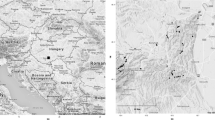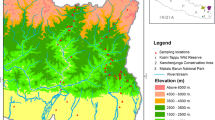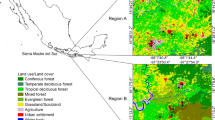Abstract
Conservation programs must be based on a detailed knowledge of the distribution of communities and populations, but this changes with the spatial scale of observation. In this context, we examined the multiscale patterns of spatial variation of a montane amphibian assemblage in Central Spain. The largest spatial scale examined (in a range of 1200 m) accounted for the maximum variability in both species richness and larval abundance, while the smallest scale examined (pond) was responsible for the maximum variation of larval abundances of many individual species. Habitat characteristics seemed to be more related to spatial variation of the amphibian assemblage at a particular spatial scale (in a range of 75 m), and distances among ponds were in part responsible for variation of larval abundance, but not species richness.
Similar content being viewed by others
References
Bosch J., Martínez-Solano I. and García-París M. 2001. Evidence of a chytrid fungus infection involved in the decline of the common midwife toad in protected areas of Central Spain. Biological Conservation 97: 331–337.
Boyero L. and Bailey R.C. 2001. Organization of macroinvertebrate communities at a hierarchy of spatial scales in a tropical stream (Coiba, Panamá). Hydrobiologia 464: 219–225.
Bradford D.F. 1991. Mass mortality and extinction in a high elevation population of Rana muscosa. Journal of Herpetology 25: 174–177.
Braña F., Frechilla L. and Orizaola G. 1996. Effect of introduced fish on amphibian assemblages in mountain lakes of northern Spain. Herpetological Journal 6: 145–148.
Carey C. 1993. Hypothesis concerning the causes of the disappearance of boreal toads from the mountains of Colorado. Conservation Biology 7: 355–362.
Doak D.F., Marino P.C. and Kareiva P.M. 1992. Spatial scale mediates the influence of habitat fragmentation on dispersal success: implications for conservation. Theoretical Population Biology 41: 315–336.
Downes B.J., Lake P.S. and Schreiber E.S.G. 1993. Spatial variation in the distribution of stream invertebrates: implications of patchiness for models of community organization. Freshwater Biology 30: 119–132.
Granados I. and Toro M. 2000. Limnología en el Parque Natural de Peñalara: nuevas aportaciones y perspectivas de futuro. In: Navalón L. and Prieto D. (eds), Segundas Jornadas Cientáficas del Parque Natural de Peñalara y del Valle de El Paular. Consejería de Medio Ambiente de la Comunidad de Madrid, pp. 55–72.
Hecnar S.J. and M'Closkey R.T. 1997a. Spatial scale and determination of species status of the green frog. Conservation Biology 11: 670–682.
Hecnar S.J. and M'Closkey R.T. 1997b. The effects of predatory fish on amphibian species richness and distribution. Biological Conservation 79: 123–131.
Hill M.O. and Gauch H.G. Jr. 1980. Detrended correspondence analysis, an improved ordination technique. Vegetatio 42: 47–50.
Levin S.A. 1992. The problem of pattern and scale in ecology. Ecology 73: 1943–1967.
Lewis C.A., Lester N.P., Bradshaw A.D., Fitzgibbon J.E., Fuller K., Hakanson L. et al. 1996. Considerations of scale in habitat conservation and restoration. Canadian Journal of Fisheries and Aquatic Sciences 53: 440–445.
Lips K. 1998. Decline of a tropical montane amphibian fauna. Conservation Biology 12: 106–117.
Martínez-Solano I., Bosch J. and García-París M. 2003. Demographic trends and community stability in a montane amphibian assemblage. Conservation Biology 17: 238–244.
Martínez-Solano I., García-París M. and Bosch J. 2002. Los anfibios de Peñalara: evaluación de su estado de conservacíon y bases para su gestión. In: Prieto D. and Navalon L. (eds), Terceras Jornadas Científicas del Parque Natural de Penalara y del Valle del Paular. Consejería de Medio Ambiente de la Comunidad de Madrid, pp. 53–64.
Noss R.F. 1992. Issues of scale in conservation biology. In: Fiedler P.L. and Jain S.K. (eds), Conservation Biology: The Theory and Practice of Nature Conservation, Preservation and Management. Chapman & Hall, London.
Richards S.J., McDonald K.R. and Alford R.A. 1993. Declines in populations of Australia's endemic tropical rainforest frogs. Pacific Conservation Biology 1: 66–77.
Schonewald-Cox C., Azari R. and Blume S. 1991. Scale, variable density, and conservation planning for mammalian carnivores. Conservation Biology 5: 491–495.
Schwartz M.W. 1999. Choosing the appropriate scale of reserves for conservation. Annual Review of Ecology and Systematics 30: 83–108.
Underwood A.J. 1997. Experiments in Ecology. Cambridge University Press, Cambridge, UK.
Van Horne B. 1982. Niches of adult and juvenile deer mice (Peromyscus maniculatus) in seral stages of coniferous forest. Ecology 63: 992–1003.
Wiens J.A. 1989. Spatial scaling in ecology. Functional Ecology 3: 385–397.
Author information
Authors and Affiliations
Corresponding author
Rights and permissions
About this article
Cite this article
Bosch, J., Boyero, L. & Martínez-Solano, Í. Spatial scales for the management of amphibian populations. Biodiversity and Conservation 13, 409–420 (2004). https://doi.org/10.1023/B:BIOC.0000006506.18453.c9
Issue Date:
DOI: https://doi.org/10.1023/B:BIOC.0000006506.18453.c9




